Life, it seems to me, is full of noise. There is an awful lot of confusion over what is important and what is simply being made to seem important, all the things other people bluster and fuss over. The stuff we are told ought to be worried and fretted over. Sometimes, when you stand back and take a breath, you see that, really, it needn't be quite so anxiety inducing. That it's just others projecting their wants and needs, transferring their stresses and cares.
This being a blog that concerns itself with nature and wildlife I am, of course, on the brink of telling you all about how I go to nature to unwind, and take a step back from the anxieties of day-to-day life. And I do find a kind of meditative peace in the embrace of our natural world. I hope that as you read this little list of ways in which nature helps me to unwind, you remember to find a little pool of peace in this often confusing world for yourself.
1. Silence and stillness in a nature reserve
I believe that nature does not ask without giving. It does require from us that we care, understand, and appreciate, but if we can foster that care and appreciation, if we can nurture it, then nature rewards us. Perhaps the most precious gifts it can bestow are those lessons in the value of silence and stillness. It is when we can be still and silent, just watching and breathing, that nature rewards us by revealing the beauty of its grace and interconnectedness. When we stop still, more and more comes forth from the verdant canopies and undergrowth, put at ease by our calm.
If we can love nature, appreciate its beauty and intelligence, naturally a consideration follows. Then we come closer to a state of peacefulness and wellbeing. Not quite Nirvana, perhaps, but something wonderful.
2. The sound of raindrops
There are many sounds from nature that I could have chosen for their calming effects. There is birdsong, the sound of wind through the treetops, or the sound of a natural spring passing over rock. I choose the sound of rain falling because, as I type, rain is falling outside my window. There is an inexpensive little storage unit out there, with a thin corrugated metal roof, and listening to the drops performing their percussive song upon it is extremely relaxing. At night, when all else is quieted, there is something gorgeous about falling asleep with rain against windows and roof.
3.Smelling the flowers
Plants are fascinating in their beauty, and also in what they are capable of. In supplying food, and shelter, and their giving us breathable air, even cleaning water, their value is priceless. That alone would be enough, but there are a number of studies which also reveal plants as being beneficial to mental health. A quick internet search even throws up a study from the University of Michigan which found that time spent outdoors, amongst plants, can increase memory retention.
For those with a green thumb, and budding gardeners, there is a little extra good news. There is a bacteria found in soil, mycobacterium vaccae, which has been found to have effects on neurons similar to antidepressants, stimulating serotonin production. Digging in soil can stir up these microbes which, when inhaled, can make you feel relaxed and happier.
4. Sunlight on my face
Raindrops sound just fine, but I much prefer the feel of sunlight on my face over rainwater!
Ah, some of that precious, precious Vitamin D, please!
Vitamin D, as well as helping to regulate the amount of calcium and phosphate in the body, has been shown to have an effect on low moods. Studies have shown that low levels of vitamin D have been linked to depression and that, in some cases, increasing vitamin D can improve low moods. The body creates vitamin D from direct sunlight on the skin, so as the spring and summer months bring brighter and longer days, getting out in the sunshine is a must for those that want to unwind.
5. The taste of fruits and veggies
There is something extraordinarily satisfying about picking a fruit or vegetable from a plant that you have nurtured from a seed or a small potted plant. Along the way, there is all the fascination of watching them grow, and the surprise at their strength and ability. Then, to see blossoms become fruit, and to taste the sweetness of them. It reintroduces an appreciation for food, growing something for yourself, that might be lost by simply selecting it from supermarket shelves and having it delivered to your door.
Thank you for reading. Just before you go, can I ask you to please consider supporting this blog with a coffee from ko-fi.com - the caffeine certainly isn't relaxing, but it does keep me writing!
I resist ad space, wanting to generate more than sales here and, with writerly ambitions, I throw myself on the kindness of readers to support this blog and my endeavours and adventures in writing.
If you can, please visit ko-fi.com, where you will also find links to other blog posts and other of my writing.

.jpg)























